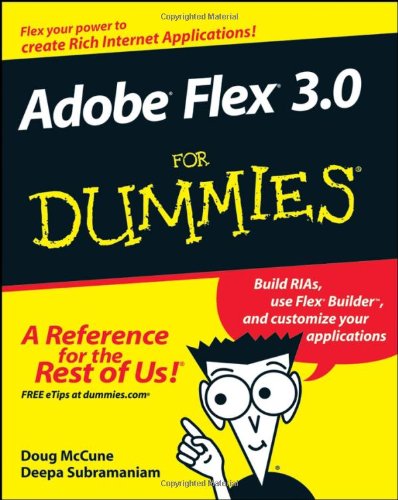

Most ebook files are in PDF format, so you can easily read them using various software such as Foxit Reader or directly on the Google Chrome browser.
Some ebook files are released by publishers in other formats such as .awz, .mobi, .epub, .fb2, etc. You may need to install specific software to read these formats on mobile/PC, such as Calibre.
Please read the tutorial at this link. https://ebooknice.com/page/post?id=faq
We offer FREE conversion to the popular formats you request; however, this may take some time. Therefore, right after payment, please email us, and we will try to provide the service as quickly as possible.
For some exceptional file formats or broken links (if any), please refrain from opening any disputes. Instead, email us first, and we will try to assist within a maximum of 6 hours.
EbookNice Team

Status:
Available0.0
0 reviews(Ebook) Adobe flex 3.0 for dummies 1st Edition by Doug McCune, Deepa Subramaniam - Ebook PDF Instant Download/Delivery: 9780470277928 ,0470277920
Full download (Ebook) Adobe flex 3.0 for dummies 1st Edition after payment

Product details:
ISBN 10: 0470277920
ISBN 13: 9780470277928
Author: Doug McCune, Deepa Subramaniam
(Ebook) Adobe flex 3.0 for dummies 1st Edition Table of contents:
Chapter 1: Getting to Know Flex
Using Flex to Develop Rich Internet Applications
Comparing Flex to Flash, AJAX, and Silverlight
Taking Flex to the Desktop with AIR
Chapter 2: Building Your First Flex Application
Creating a Flex Project in Flex Builder
Writing Code for Your Project
Viewing Your Application in Design Mode
Running the Application
Chapter 3: Flexing Your Muscle with MXML and ActionScript
Introducing MXML
Introducing ActionScript
Understanding the Relationship Between ActionScript and MXML
Working with the Event Model
Chapter 4: Flex Builder: The Best Flex Development Tool
What’s Flex Builder, and Why Should I Care?
Creating Different Types of Projects
Organizing and Editing Your Projects
Importing and Exporting Projects
Running and Releasing Projects
Accessing Help Materials
Chapter 5: Introducing Flex Builder for Developers
Anatomy of an MXML File
Developer Tips and Tricks
Squashing Bugs with the Visual Debugger
Profiling Your Application
Refactoring Your Code
Chapter 6: Visually Designing Applications in Flex Builder
Getting to Know Design Mode
Navigating the Design Area
Selecting and Configuring Controls
Inserting Components
Viewing Application Outline
Working with States and Style Sheets
Chapter 7: Simple User Interface Controls
Clickable Controls
Text and Media Controls
Example: Video Player
Chapter 8: Data-Aware User Interface Controls
Understanding dataProvider
Creating Flash and Flex Data Objects
Using Scrolling List and DataGrid Controls
Hierarchical and Customized Display Controls
Chapter 9: Forms, Formatters, and Validators
Form Layouts
Validation
Formatting
Example: E-Commerce Form
Chapter 10: Containers and Navigators
Basic and Panel Containers
Navigators
Example: Multi-Part Form
Chapter 11: Charting Components
Column, Bar, Line, Area, and Pie Charts
Plot, Bubble, CandleStick, and HLOC Charts
Working with Axes, Legends, Interactivity, and Animation
Chapter 12: The Power of Data Binding
Data Binding Expressions
Binding in MXML
Bindable Metadata and Debugging
Example: Interactive Form
Chapter 13: Working with Data Collections
Using ArrayCollections and XMLListCollections
Sorting, Filtering, and Accessing Data
Chapter 14: Working with Remote Data
HTTP Connections
Web Services
AMF Remoting
Chapter 15: Working with Managers We Actually Love
DragManager, FocusManager, PopUpManager, ToolTipManager, SystemManager
Chapter 16: Custom Components and Component Architecture
Flex Component Life Cycle
Creating Reusable Components
Chapter 17: Understanding States and Effects
View States
Adding Effects and Transitions
Chapter 18: Styling and Skinning Flex Components
Styling
Skinning
Chapter 19: Ten Open-Source Flex Libraries
FlexLib, Flex Scheduling Framework, Visual Graph Library, Degrafa, OpenFlux
FlexUnit, Cairngorm, Flex-Spy, PaperVision 3D, APE and Box 2D
Chapter 20: Ten Flex Resources
flexcoders Yahoo! Group
Flex Developer Center
Flex User Groups
Interface Guidelines, Blogs, Open-Source Sites
Conferences, Flex.org, Public Bugbase, flexjobs Yahoo! Group
People also search for (Ebook) Adobe flex 3.0 for dummies 1st Edition:
macromedia flex
adobe acrobat pro for dummies pdf
adobe pdf for dummies
flex 3.0 ordering guide
adobe flex end of life
Tags: Doug McCune, Deepa Subramaniam, Adobe flex